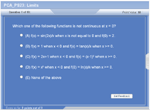Limits and Rates of Change
| Rapid Study Kit for "Title": |
| Flash Movie |
Flash Game |
Flash Card |
| Core Concept Tutorial |
Problem Solving Drill |
Review Cheat Sheet |
 |
 |
 |
|
| "Title" Tutorial Summary : |
This tutorial discusses the limits and the rates of change. Knowing the concept of limit process and instantaneous change is important to the formulation of derivatives and approximation of solutions. The different types of limits that one gets are discussed in the graphical illustrations.
Properties of limits and limit operations are presented so an evaluation of limits can be performed. An example of how a function can have no limit but be bounded by 1 is discussed. The principle of continuity relies on limits and it has properties that are useful with the rates of change concept.
|
| Tutorial Features: |
Specific Tutorial Features:
• Graphical illustration of one sided limits and the continuity of functions is shown in the examples.
• Typical rate of change problems are introduced with graphical interpretations.
Series Features:
• Concept map showing inter-connections of new concepts in this tutorial and those previously introduced.
• Definition slides introduce terms as they are needed.
• Visual representation of concepts
• Animated examples—worked out step by step
• A concise summary is given at the conclusion of the tutorial.
|
| "Title" Topic List: |
Limit of functions
Definition of limits
Limit operations
Properties of limits
One sided limits
Continuity
Definition of the continuity of functions
One sided continuity
Properties of continuous functions
Rate of change
Derivative operations
|
See all 24 lessons in Pre-Calculus, including concept tutorials, problem drills and cheat sheets:
Teach Yourself Pre-Calculus Visually in 24 Hours |



